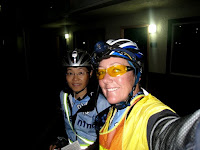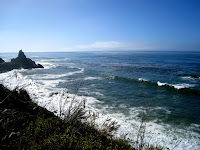 When did you ride your first brevet? My first 200K was the Platteville Poke-Along [Permanent] in April, 2006.
When did you ride your first brevet? My first 200K was the Platteville Poke-Along [Permanent] in April, 2006.Your brevet/rando experience up to this point? I did another 200K, the Kersey Kick, in 2007, and 4 200Ks in 2008.
How did your previous rando or other experience help you? I began cycling in 2003, but before 2008, never rode more than 2000 miles in a year. I was a nordic ski racer when I was younger, though, which taught me to keep pushing through suffering. Brevets and populaires exposed me to the habits of randonneurs, introduced me to local folks and gave me an opportunity to learn about equipment, strategies, etc.
Did you do any specific training for successive, longer SR events? I didn’t start 2009 with completing an SR, let along the Last Chance, as a goal; I was training to ride the San Juan Skyway loop with a friend. When that ride fell apart, I reconsidered and decided to see how far I could go in the SR and Last Chance. In talking to experienced ultra riders, I learned that there are two basic approaches to training for these distances, speed work and distance work. Having never ridden more than 125 miles in a day, I opted for distance, riding lots of 200Ks, centuries, back-to-back distance, etc. I tried to do as much of that in the context of organized rides as I could, both because I enjoy them and because I thought they’d motivate me to get out and do the training. I did some speedwork, generally once or twice a week, and really stressed listening to my body – if I was tired or really unmotivated, I didn’t ride. Ultimately, I found that while training is really important, the right frame of mind took me a long way, so wearing myself too thin would have worked against me. All in all, I rode 3 centuries, 6 200Ks, 2 300Ks, a 400K and a 600K before the LC – not as much as I would have liked, but as much as I could handle.
What were the challenges moving up to the longer distances? 1. Confidence that I could complete the rides and that nothing would go wrong (or that I could deal with whatever did go wrong). 2. Learning to eat and drink properly (which I still haven’t mastered) – the most important note on this is that since I love to ride, if I start feeling negative or down, that means I’m low on calories. 3. My butt (and bike comfort/fit in general): I went through several saddles over the course of the season and still haven’t found one that’s ideal – I had bad saddle sores on the LC, though I was fine on the 600K.
How many years of working towards the SR award did it take you? Setbacks overcome? I guess 3, this being my fourth year of brevets, but really only the second of significant mileage. I had some frustrating mechanical moments (a diesel car that wouldn’t start on the morning of a 300K, a broken headset the night before a 400K), lots of aches and pains (again, listen to your body!) and lots of low moments, but the moments of pure joy and pride, the senses of camaraderie and accomplishment, all the stuff I’ve seen and will see from the seat of my bicycle – all these things made the work worthwhile for me.
Any particular strategies (nutrition, pace, sleeping)? On rides up to one full day – i.e., 400K – I depended mostly on Hammer products, including some of their supplements. I found on the second day and beyond, however, I had to have solid food. This included bars and gels, as well as sandwiches, burritos and the occasional ice cream, but no more liquid nutrition. The most important thing is to eat and drink. If it looks good, it will probably taste good, but homemade (as opposed to frozen/microwaveable) is, in my opinion, better. Pace-wise, I probably rode more conservatively than I needed to. I finished with respectable times, but rarely pushed my heart rate above the mid-130s. That’s one reason why I may play around with more speedwork this year, to help improve my times and stay with quicker riders. As for sleeping, I am not cut out for RAAM, that’s for sure. On various rides, I had anywhere from 4 ½ to 7 hours (my first 600K – I knew I had plenty of time and would be riding the second day alone, so I just took it easy). The one time I slept less was the last night of the Last Chance, when my roommate took off after I’d been sleeping for only an hour and a half and I couldn’t get back to sleep. That ended up being kind of dangerous, as I really struggled to stay awake riding in the dark and at one point got very cold. Finally, it took me a long time to learn that waiting for people for a few minutes pays off in the end. What’s 5 minutes over 36 hours? The benefit of company and protection from the wind more than makes up for the slight delay, in my opinion.
Any other tips or words of wisdom? Do some long rides, but don’t over do it. If you’re mentally strong, you can make up shortages in training distances. Work on fueling strategies and pay attention to them on the bike. Make sure you have the right equipment, especially clothing – it took me a while to figure this out, but descending Independence pass in the snow made me pay close attention to what I was packing from then on. Finally, work on your mental strength. If you think you want to do something like the SR, chances are you are (or can become) physically strong enough to do it. The rest is mental, sticking with it when the going gets tough, enjoying it when you’re feeling good. It helped me to remember that no matter the circumstances, I was out on my bike seeing the world, which to me is always a good thing.
- Stephen










 Team Deer with Headlights on the Flèche. - Catherine Shenk photo
Team Deer with Headlights on the Flèche. - Catherine Shenk photo  So it was especially gratifying that, a mere three days after a two-foot dump of late October snow, roads had cleared beautifully just in time for seven riders to seize the day - the first day of the month, to be specific - for a November ride.
So it was especially gratifying that, a mere three days after a two-foot dump of late October snow, roads had cleared beautifully just in time for seven riders to seize the day - the first day of the month, to be specific - for a November ride. Riders pulling into Roggen were eagerly apprised of those who'd come before by the proprietor of the control store. Tammie Nakamura enjoys a snack in Roggen, in front of some snow remnant:
Riders pulling into Roggen were eagerly apprised of those who'd come before by the proprietor of the control store. Tammie Nakamura enjoys a snack in Roggen, in front of some snow remnant:



















 Here's some of what's in store:
Here's some of what's in store:

 We climbed windswept Lookout Mountain in the dark, the lights of Golden twinkling below. Our routes parted at El Rancho, and the randonneurs headed out on their separate forays. First dawn light hits the golden aspen on the Squaw Pass Road:
We climbed windswept Lookout Mountain in the dark, the lights of Golden twinkling below. Our routes parted at El Rancho, and the randonneurs headed out on their separate forays. First dawn light hits the golden aspen on the Squaw Pass Road: Here's Squaw Pass Summit, still six miles from the high point of Hwy. 103, which tops out at 11,000 ft., above Echo Lake:
Here's Squaw Pass Summit, still six miles from the high point of Hwy. 103, which tops out at 11,000 ft., above Echo Lake:












 After the plunge through Central City and Blackhawk, and the six mile climb back up, the sweeping Peak-to-Peak Highway has more good vistas to offer:
After the plunge through Central City and Blackhawk, and the six mile climb back up, the sweeping Peak-to-Peak Highway has more good vistas to offer: 

